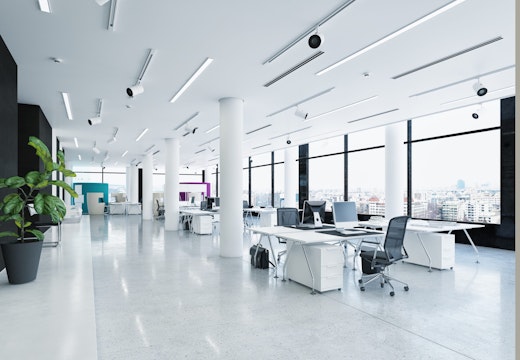Neuroscience research supports designing to counter burnout
Can the design of the physical environment counteract exhaustion and anxiety at work? A new Dutch study on lighting levels adds to a growing body of evidence in the field
The neuroscience evidence continues to grow that design can make workplace burnout less likely.
A new study by a research team from Eindhoven University of Technology in the Netherlands (Frick and colleagues, in press) assessed 50 healthy employees over seven days to explore the links between higher light levels and one burnout condition – exhaustion. It found that when individuals were exposed to a higher hourly illuminance compared to their personal average exposure, subsequent experiences of momentary exhaustion were lower.
The results confirm, says the study, that ‘while adequate lighting is important for all employees, a higher illuminance might be needed for employees regularly suffering from burnout-related symptoms to alleviate their feelings of exhaustion.’
Tipping the scales
It’s important to establish upfront that design isn’t magic and can’t always eliminate burnout. There is nothing design can do to alleviate the psychological consequences to employees of bosses who send text messages at 3am and expect an immediate reply, for example. In more borderline situations, however, when people might or might not find themselves burned out, design can tip the scales to more positive mental health, as earlier studies confirm.
Maslach and Leiter (2017) report that there are ‘three basic dimensions of the burnout experience: an overwhelming exhaustion, feelings of cynicism and detachment from the job, and a sense of ineffectiveness and lack of accomplishment.’ They also describe factors contributing to burnout such as excessive workload, lack of control, lack of fairness, and insufficient reward (whether financial, institutional or social). Research reported on the WORKTECH Academy platform indicates that design can counter Maslach and Leiter’s burnout risk factors.
Lighting, ventilation and floor planning—along with many other components of interior environments—have been shown to affect employees’ performance and their ability to effectively meet workload challenges. Workplaces that align with and support the activities-at-hand (e.g. spaces where people can concentrate if their work requires focus) give users at least a fighting chance to avoid becoming burned out. Ways that work environments can counter mental fatigue—such as by including gently moving water (for example, in indoor fountains), green leafy plants and natural materials, or natural soundscapes—are also well documented in the neuroscience literature and have been discussed in past editions of this column.
Level of control
The human need to have a comfortable level of control over the physical and virtual environments around us is also well documented—as are the ways that design can satisfy it. For example, in the context of activity-based working, which encourages employees to choose seats in the best onsite space available for whatever sort of work they are doing, Appel-Meulenbroek et al (2020) report on three dimensions of burnout: exhaustion-to-energy, cynicism-to-involvement and inefficacy-to-efficacy. To avoid burnout, the study advises that workplace managers should aim at maximising interaction and desk switching, whilst at same time minimising noise distractions.
Augustin, Milota, and Bucci (2023) used a burnout scale to survey users of a coworking site. Study participants were divided into three equal sets based on burnout scale scores. The set that was the least burned out was significantly more likely to describe their mood as positive when sitting where they were most likely to work. Many environmental factors influenced this mood. Among the third of the participants scoring most burned out, all were able to hear other people talking and all had a view mainly of buildings or other manmade things as they worked, as opposed to views mainly of nature.
Design can make it clear that professional recognition is fair, access to resources is equitable, and values espoused by organisations in their value statements are guiding management actions. All design-based messaging needs to be validated via discussions with employees to make sure it is ‘on target’ and that the silent signals sent by the workplace are reaching their intended audience. One can conclude from neuroscience research that the physical environment can be deployed strategically to make burnout less likely, even as tension levels build in workplaces worldwide.
Read more of the latest research insights from Sally Augustin in Research Roundup, her regular column in the Innovation Zone for WORKTECH Academy members and partners here.
Read Sally Augustin’s full article on the Innovation Zone here.
Research sources
Rianne Appel-Meulenbroek, Rik Aussems, Pascale LeBlanc, and Theo Arentze. 2020. ‘The Association Between Office Use and the Burnout-Engagement Continuum in Activity-Based Offices.’ Proceedings, The Transdisciplinary Workplace Research Network Conference, September 16-19, Frankfurt Germany.
Sally Augustin, Cynthia Milota, and Deborah Bucci. 2023. ‘Applying Neuroscience to Combat Burnout,’ 20th Anniversary Conference Proceedings (Academy of Neuroscience for Architecture), pp.32-33.
Sophia Frick, Karin Smolders, Leander van der Meij, Evangelia Demerouti, and Yvonne de Kort. ‘A Higher Illuminance Reduces Momentary Exhaustion in Exhausted Employees: Results from a Field Study.’ Journal of Environmental Psychology, in press.
Christina Maslach and Michael Leiter. 2017. ‘ Understanding Burnout: New Models.’ In Cary Cooper and James Quick (eds.), The Handbook of Stress and Health: A Guide to Research and Practice, Wiley, pp. 37-56.








